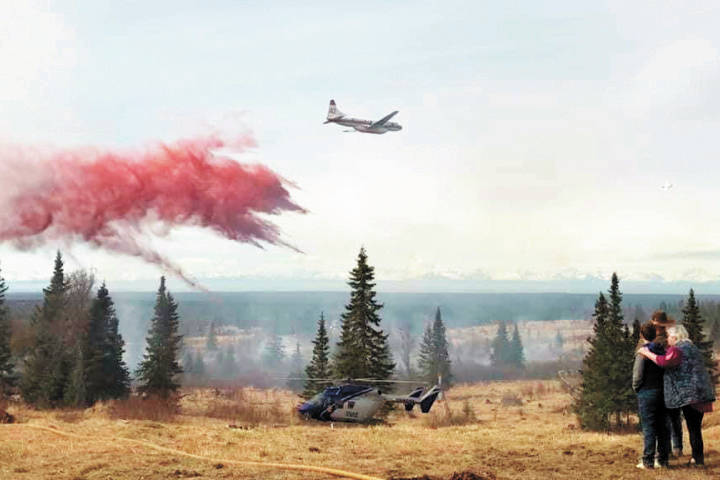Firefighters from Ninilchik and Soldotna on Sunday contained a wildland fire in the Caribou Hills near Ninilchik that threatened two homes in the area.
The human-caused blaze — called the Murray Fire — was determined to have been started by “juveniles playing with fireworks” on Sunday, according to a report by the Alaska Division of Forestry on the Alaska Wildland Fire Information website. Firefighters from the volunteer department Ninilchik Emergency Services were called to the fire around 2 p.m., and Assistant Chief Grace Huhndorf said firefighters with the Alaska Division of Forestry from Soldotna showed up almost simultaneously.
The grass fire was reported near Mile 17 Oil Well Road, according to the Division of Forestry. Originally identified as about a half acre in size, the grass fire grew to 2.4 acres before firefighters were able to contain it roughly two hours later. Northwest winds pushed the fire close to four structures that were to the south, according to the Division of Forestry.
According to Huhndorf, the fire was situated between two properties. If hadn’t been for a shift in the wind and for the Division of Forestry presence, things could have gotten ugly, she said.
The Ninilchik Emergency Service volunteers worked to get water on the fire from the ground while an attack on the fire was also executed from the air.
A pair of ATV trails on either side of the fire were used as containment lines, the Division of Forestry wrote in its online post. The division also used an air tanker based in Palmer to drop 2,000 gallons of fire retardant onto the blaze. This was the first use of retardant by the Division of Forestry this season.
A helicopter from the Kenai/Kodiak Area Forestry station on Soldotna was also used to dump water on the blaze. In addition to the Ninilchik Emergency Services firefighters, 10 firefighters from the Yukon Fire Crew in Soldotna worked to contain the fire. Central Emergency Services provided mutual aid, Huhndorf said.
Ninilchik Emergency Services brought two tenders and one engine to fight the fire.
The air tanker was one of two Convair 580 air tankers that are contracted by the Division of Forestry from Conair Group Inc. which works out of Abbottsford, British Columbia, according to the division. The second air tanker will be based in Fairbanks.
Huhndorf said the Kenai Peninsula is at very-high fire risk currently, with all the dry fuels — like grasses — exposed on the ground and not yet turned green by rain.
“I would say that people need to be extremely cautious,” she said.
Ninilchik Emergency Services is a volunteer department that doesn’t have the resources to fight major wildland fires on its own, Huhndorf reminded the community.
The Division of Forestry has already responded to several fires across the state so far this season. The U.S. Forest Service responded to a wildfire in Juneau on Saturday. The division suspended all permits for burning starting May 1, with an exception for Southeast Alaska. Small camping and warming fires no more than 3 feet in diameter with flames no more than 2 feet high are still allowed.
Tim Mowry, public information officer for the Division of Forestry, said that people need to be careful and use common sense while the state is still in the process of greening up. While camping fires are still technically allowed, he said the division is advising people not to have them while dry conditions persist.
“Fire danger is very high on the Kenai Peninsula right now due to all the dead, dry grass that has been exposed by the melting snow,” Mowry wrote in an email. “This is a very dangerous time of year. All it takes is one spark to ignite dead, dry grass and grass fires spread extremely quick, especially if there is any kind of wind.”
Fireworks do not require permits from the Division of Forestry and are handled by the State Fire Marshal office, Mowry said. His advice, though, is that people hold off on lighting them during the summer season.
Fireworks are prohibited in the Kenai Peninsula Borough outside of city limits, except for displays permitted by the borough.
“For example, in Delta Junction this weekend there was a grass fire started by someone throwing burned popcorn onto a lawn,” he wrote. “Hot chainsaws on dry grass, sparks from dragging trailer chains, dry grass on an ATV muffler … those are just a few ways, in addition to fireworks, that grass fires can be started. The best advice I would give people regarding fireworks is to wait until the winter to light them off when you can actually see them.”
Mowry explained that a major factor in the Division of Forestry suspending burn permits is the uncertainty surrounding the firefighting resources Alaska normally relies on in the summer: firefighters from the Lower 48. As long as Alaska still has a mandatory 14-day self quarantine in place for anyone entering the state, this resource will be limited.
“We want to do everything possible to reduce human-caused fires, which in turn limits exposure of our firefighters to potential COVID-19,” Mowry wrote.
Mowry said the Division of Forestry is working with the Alaska Department of Health and Social Services to make a process for getting Lower 48 firefighters up to Alaska in a timely manner, but that their availability will likely still be limited.
“I know that burn restrictions are a bit of a nuisance to some people, but people need to be conscious of our situation right now,” Huhndorf said.
Reach Megan Pacer at mpacer@homernews.com.
The article has been updated to correct that it was the U.S. Forest Service that responded to the wildfire in Juneau.

